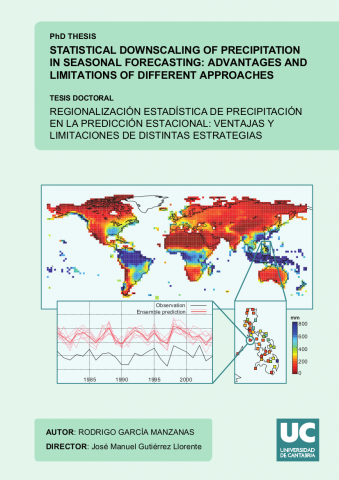Our colleague at Predictia, Rodrigo Manzanas, has presented his Phd Thesis titled Statistical downscaling of precipitation in seasonal forecasting: Advantages and limitations of different approaches.
Seasonal climate predictions, which aim to predict the average conditions for the next seasons some months in advance, have a great number of applications and can help decision-making in many important socioeconomic sectors such as agriculture, energy, health or tourism. Among the most interesting variables for the end-user, temperature and precipitation, this Thesis focuses exclusively on the latter. Nowadays, seasonal forecasts are operationally produced by means of complex numerical models which simulate the evolution of the climate system up to one year ahead in time.
However, as a consequence of the chaotic nature of this system, these predictions only show acceptable skill for some particular regions and seasons. Moreover, as a result of the limited computational resources available, the low spatial resolution (around hundreds of km) of the models used is insufficient for most of impact applications. Therefore, some kind of post-process is required in order to translate their coarse predictions to the useful, local-scale. One of the existing alternative to this aim is statistical downscaling (SD), which is based on statistical techniques that relate the low resolution outputs from the models with the meteorological observations available for the points of interest. Nevertheless, whereas these techniques have been extensively applied for climate change modeling, there is only limited experience regarding their application for seasonal forecasting.
Therefore, besides providing an exhaustive global validation of seasonal precipitation forecasts worldwide, which allows for identifying the regions with the highest potential for this kind of prediction, this Thesis focuses on adapting the different approaches and techniques for SD for their correct application in the context of seasonal forecasting, analyzing a number of aspects which have been rarely taken into account to-date, such as the effect of reanalysis uncertainty on the downscaled forecasts. Likewise, the advantages and limitations of the different approaches available for SD are analyzed for an especially interesting region of study which poses an important scientific challenge: the Philippines.
As a result of the investigation undertaken, this Thesis establishes a methodological framework of reference for future SD studies in the context of seasonal forecasting.

